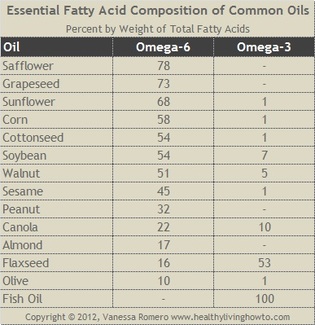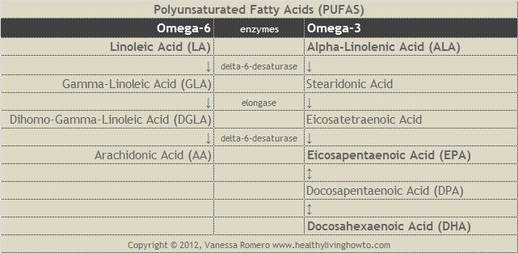NUTRITIONAL STRATEGIES TO IMPROVE BLOOD LEVELS OF OMEGA-3
Based on the recommendations of renowned and respected Omega-3 experts, Dr. Doug Bibus and Dr. Bill Lands, the best way to improve blood levels of Omega-3 is by reducing Omega-6 intake meanwhile increasing Omega-3 intake by consuming sources of ALA, EPA, DPA and DHA.
STEP ONE: REDUCE OMEGA-6 INTAKE
With the exception of flaxseed oil and fish oil, all the common oils used today are predominantly Omega-6. These oils, especially soybean and corn, are used excessively in the current food supply. In fact, according to the USDA, Americans get nearly 20% of their calories in the form of soybean oil.
You can cut your Omega-6 intake drastically, simply by:
Cutting Out Processed Foods
Nearly all the processed foods found in the inner aisles of your local grocery store contain soybean, corn and/or canola oil. By choosing whole foods over processed you will significantly slash your Omega-6 intake.
Reading Labels
Along with cutting down on processed foods, become an expert at reading labels for those foods that still come in a package or bottle. Scan the ingredients for not only words like partially hydrogenated but also for the Omega-6 heavy oils.
Making Your Own Salad Dressings & Mayonnaise
It is nearly impossible to find salad dressings or mayonnaise that do not contain soybean oil. Even those that claim they contain olive oil on the label will also have added soybean, canola or some form of vegetable oil. Making your own dressings using olive oil is easy and will taste better than store-bought.
Switching Polyunsaturated Cooking Oil/Fats For Saturated
The health issues with using Omega-6 oils in your kitchen are two-fold. We already know what the high consumption of these oils are doing to our Omega-6:3 balance, but the other problem is these highly refined oils, are oftentimes unstable, rancid and oxidized. Rancid oils are a major source of destructive free radicals in our diet. To make matters worse, this issue is compounded by heat/cooking. Contrary to conventional wisdom, the only fats you should be cooking with are stable saturated fats, like butter, ghee, coconut oil, tallow and lard. Not only is their Omega-6 composition low or nil, they are extremely stable when heated.
Eating Out Less
Anytime you eat in a restaurant you are going to be consuming not only Omega-6 oils but also trans fats. Restaurants use polyunsaturated Omega-6 oils, primarily soybean, peanut and corn, because they are cheap and cut their operating costs.
STEP TWO: INCREASE OMEGA-3 INTAKE
A relatively small number of Omega-3 food sources actually increase blood levels of Omega-3 without the reduction of Omega-6 intake. Essential fatty acids start out as parent molecules, Linoleic Acid (LA) and Alpha Linolenic Acid (ALA). Through enzymes these are converted to the different byproducts which impact our health. Here's where the issue lies, these byproducts compete for the same enzyme for conversion. The Omega-3 family of fats start out as ALA and then metabolize into eicosaenoic acid (EPA), docosapentaenoic acid (DPA) and docosahexaenoic acid (DHA). The two key Omega-3 fatty acids we want to increase in our blood are EPA and DHA.
In addition to decreasing Omega-6 intake you can increase blood levels of the Omega-3 fatty acids by:
Taking Fish Oil Supplements
There is number of high-quality fish oil supplements on the market. Be sure to look for one that is mercury free with high doses of EPA and DHA, at least 50% of the oil should come from these. Some studies have shown health benefits can be achieved with as little as two grams per day, while others have used higher levels.
Eating Oily Fish
Deep cold water oily fish offer the highest amount of EPA and DHA, fish like salmon, halibut, sardines, halibut and fresh tuna. Eating enough fish to significantly increase Omega-3 blood levels would require a minimum daily serving of 3 oz, this carries some concern about consuming toxins, such as PCBs and mercury. To eliminate some of the risk, be sure to avoid farm-raised fish and stick with wild caught.
A “Smattering” Of Foods Rich in ALA
Plant foods like flax seeds, hemp seeds, chia seeds and walnuts are rich in ALA. The body's ability to convert ALA to EPA and DHA and increase blood levels is an ongoing debate. What we know is when Omega-6 intake is significantly reduced, this conversion happens more readily.
CONCLUSION
Fatty acid metabolism is a very complex topic to understand. My goal when writing this three-part series, was to give a high level overview, equip you with some basic knowledge and steer you in the direction of healthy change. If you want to dig deeper into fatty acid metabolism, you can download and watch this outstanding presentation by Dr. Bill Lands, the world's foremost authority on essential fatty acids.
Oh Mega: Part One – Oh Mega: Part Two – Oh Mega: Recipe – Oh Mega: Part Three


